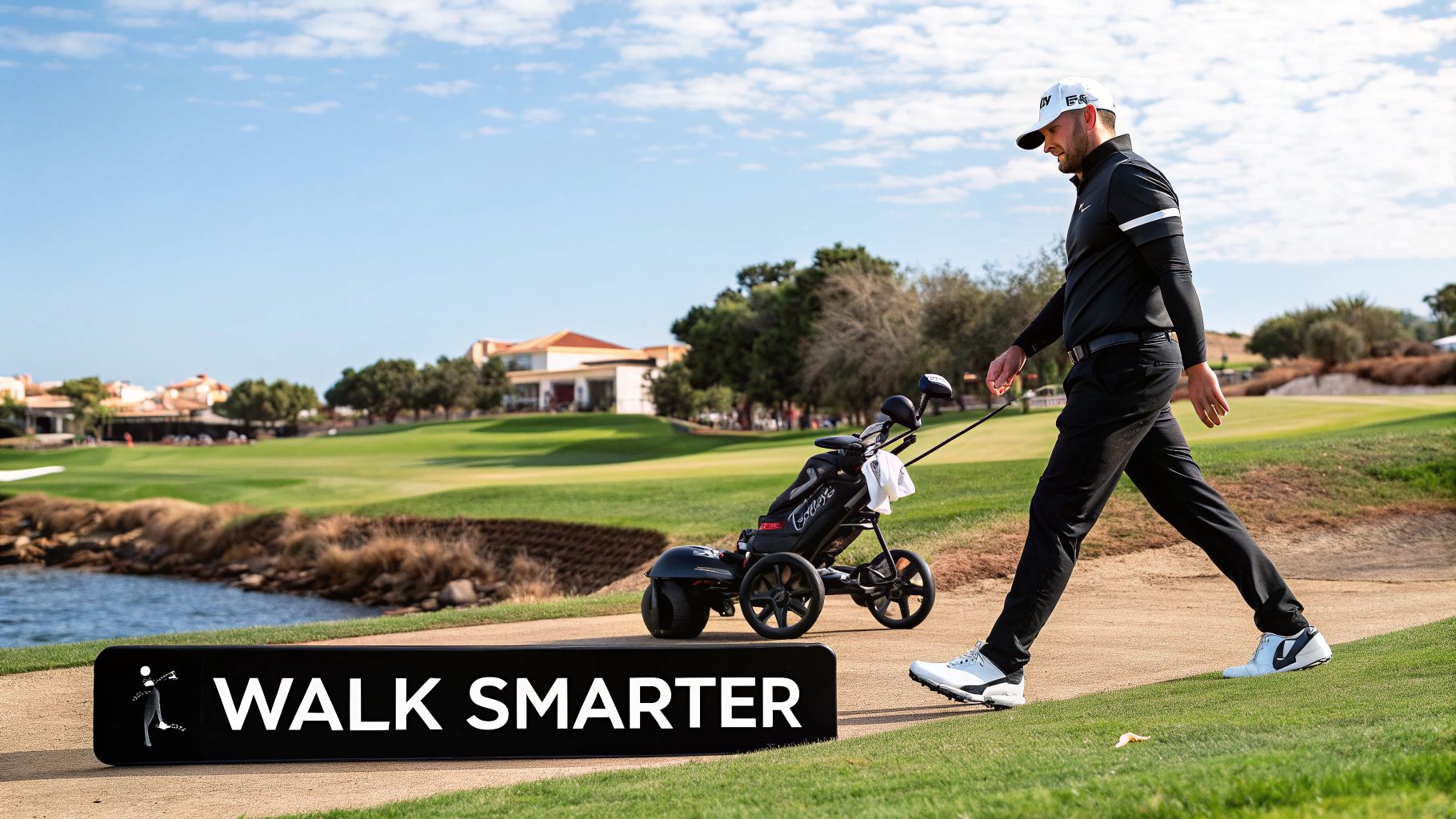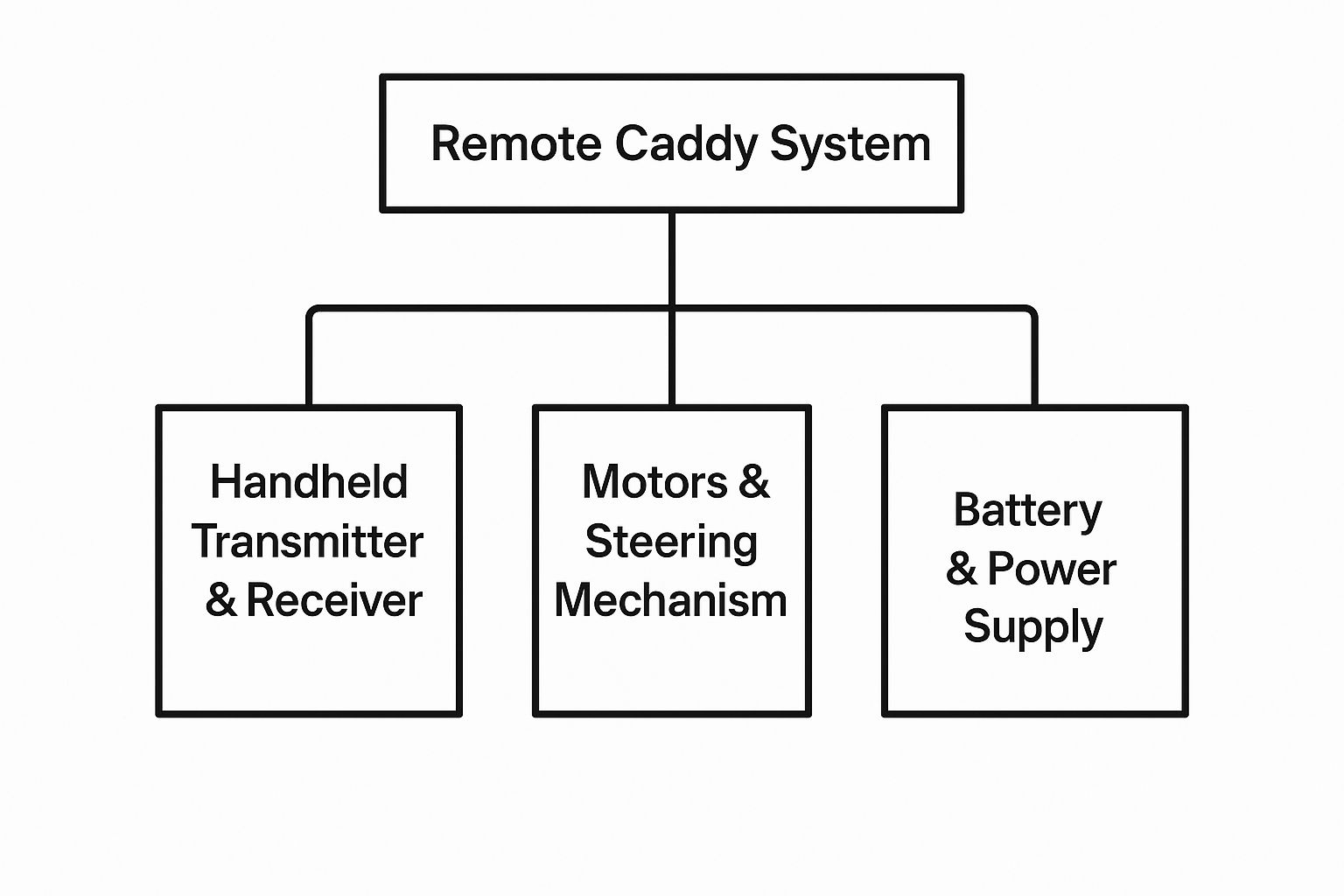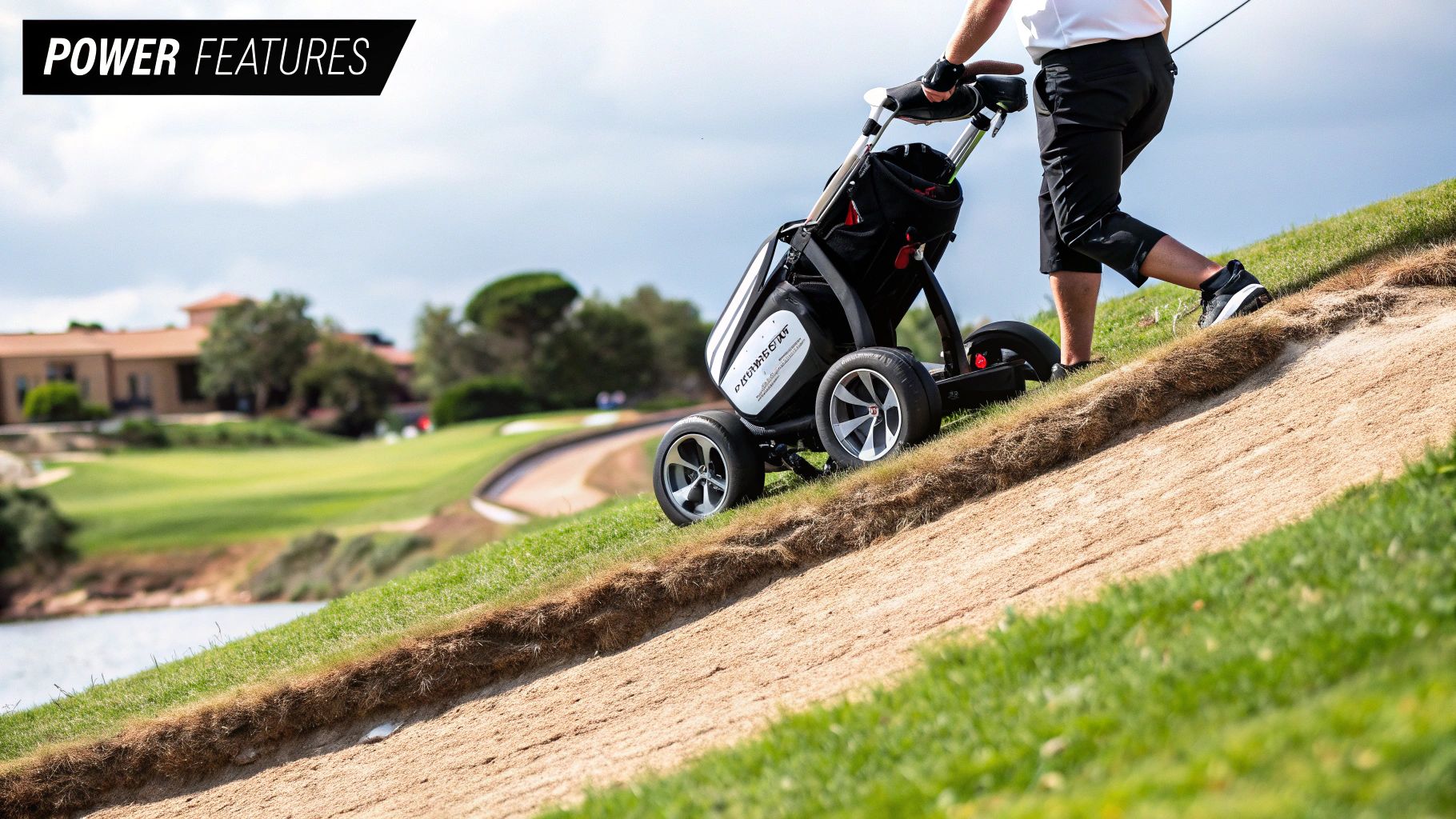Think of an electric golf caddy remote as your personal caddy's controller. It’s a simple handheld device that gives you full command over your motorized cart—letting you steer, adjust the speed, or stop it on a dime, all from a distance. This bit of tech means you get complete hands-free control, allowing you to walk the course freely while your clubs obediently tag along.
Walk the Course Smarter, Not Harder

Picture yourself stepping up to your ball on the 18th hole, feeling just as fresh and focused as you did on the first tee. That's not a fantasy; it's the reality that modern golf tech delivers. Instead of spending your energy pushing or carrying a bulky bag, you can save every ounce of it for what actually counts: your next shot.
This simple change in equipment completely redefines the golfing experience. We’ve all felt it—that late-round fatigue that creeps in after hauling your clubs for miles. It’s a huge factor in sloppy swings and poor decisions. An electric caddy just lifts that entire burden off your shoulders.
Conserve Energy for Better Performance
By letting your caddy do the heavy lifting, you’re free to put all your mental and physical energy into your game. This isn't just about feeling better; it’s a genuine strategic edge that shows up on the scorecard. Many golfers find their stamina and mental clarity are significantly sharper, especially during those crucial final holes.
The benefits go way beyond just a lower score:
- Reduced Physical Strain: Forget about the aching back, shoulders, and legs that come from shoving a heavy cart up hills and across uneven ground.
- Improved Pace of Play: You can send your caddy ahead to the next tee while you walk to your ball, or have it follow you from a distance. Either way, it helps keep the game moving.
- Enhanced Enjoyment: Walking the course becomes the relaxing, traditional experience it was meant to be, letting you soak in your surroundings without the physical punishment.
An electric caddy with a remote doesn't just carry your clubs—it carries the physical burden of the game, leaving you free to focus on strategy and execution.
For golfers of any age or skill level, this technology is all about playing smarter. It's an investment in your performance, your body, and ultimately, your love for the game.
How Remote Control Caddies Actually Work
Ever wondered what’s happening under the hood when you steer your caddy from across the fairway? Think of your electric golf caddy remote control as a sophisticated digital leash. That small handheld device in your pocket is a transmitter, and it's constantly ready to send secure signals to a receiver built right into the caddy.
When you press a button—forward, left, stop—you're not just pushing plastic. You're sending a specific command over a dedicated frequency.
That simple action kicks off a lightning-fast chain reaction. The caddy's receiver picks up your command and instantly relays it to an onboard controller. This controller then acts as the brain, drawing the precise amount of power from the battery and sending it to the quiet, powerful electric motors that drive the wheels and steering.
It’s a seamless conversation between your hand and the machine, all happening in a split second.
The Core Components of Control
The magic behind this effortless control really boils down to a few key parts working in perfect harmony. Most systems use reliable radio frequency (RF) signals—similar to what your garage door opener uses, but far more secure—to make absolutely sure your caddy only listens to your remote. A strong, stable connection is non-negotiable out on the course.
The infographic below breaks down how the transmitter, motors, and power supply create one cohesive system.

As you can see, the battery is the heart of the whole operation. It doesn't just power the motors that move the caddy; it also powers the receiver that's constantly listening for your next command.
This kind of tech is at the center of a booming market. In fact, the global remote-control electric golf caddy market is projected to grow at a compound annual growth rate of 15.2% between 2026 and 2033. This surge is driven by golfers demanding more convenience, along with big strides in GPS, lightweight materials, and powerful lithium-ion batteries. You can find more market insights over at Accio.com.
At its core, a remote caddy translates simple button presses into precise, real-world motion. The better the components—from the motor to the battery—the smoother and more reliable that motion will be across 18 holes.
Key Features That Make a Real Difference

Once you start shopping around, you’ll quickly realize that not all electric golf caddy remote control systems are created equal. Sure, most will handle the basic forward, left, and right commands, but a handful of key features truly separate the great caddies from the merely good ones. Nailing down which of these matter most to you is the secret to finding a model that feels like it was made for your game.
The Power Behind the Performance
First things first: battery longevity. Your caddy is only as useful as its power source. Most standard models are built to handle a full 18-hole round without a problem. But if you're the kind of golfer who loves a 36-hole day or plays on long, hilly tracks, you’ll want to look for a high-capacity battery. Keep in mind that power drain isn't just about distance—a heavy tour bag or soggy turf will make the motor work harder, too.
Next up is the motor’s strength and the caddy's overall stability. A weak motor is going to groan its way up steep hills, slowing you down or, even worse, giving up halfway. You’ll want to look for models that get rave reviews for their hill-climbing prowess.
Just as important are the features that keep it upright. Many of the best caddies now come with anti-tip wheels and clever balancing systems to stop them from tumbling on awkward lies or sidehills. A low center of gravity is another design trick that makes a huge difference.
A powerful motor gets you up the hill, but smart stability features are what keep your bag upright on the journey. It's the combination of both that delivers true reliability.
Game-Changing Tech
For golfers who want the latest and greatest, some seriously cool features are becoming more common. These aren't just gimmicks; they elevate the caddy from a simple cart to a genuine on-course partner.
- Automatic Downhill Braking: This is a must-have safety feature. It automatically slows the caddy on steep descents, preventing it from getting away from you and giving you complete control.
- Follow Mode: This is where things get futuristic. Using a combination of sensors and AI, some caddies can follow you completely on their own, maintaining a perfect distance without you ever touching the remote.
- Integrated GPS: Imagine getting your distances right from your caddy. Onboard GPS can navigate the course for you, showing yardages and other key info on a built-in screen.
The table below breaks down these features to help you decide what’s a ‘must-have’ versus a ‘nice-to-have’ for your specific needs on the course.
Remote Control Caddy Feature Comparison
This table compares some of the most common essential and advanced features available on modern electric golf caddies. Use it to figure out which capabilities are crucial for the courses you play and the level of convenience you're looking for.
| Feature | What It Does | Importance Level |
|---|---|---|
| High-Capacity Battery | Lasts for 27-36 holes on a single charge. | Must-Have for marathon golfers or hilly courses. |
| Powerful Motor | Climbs steep inclines without slowing down or struggling. | Must-Have for anyone who doesn't play on flat courses. |
| Anti-Tip Wheel | A small, rear-facing wheel that prevents the caddy from flipping backward on hills. | Must-Have for stability on varied terrain. |
| Automatic Downhill Braking | Senses descents and automatically applies resistance to control speed. | Essential for safety and control on hilly courses. |
| Follow Mode | Uses sensors to follow you autonomously, no remote input needed. | Nice-to-Have for the ultimate hands-free experience. |
| Integrated GPS | Displays course maps and provides yardages on a built-in screen. | Nice-to-Have for golfers who love tech and data. |
Ultimately, while the high-tech bells and whistles are exciting, the battery is still the heart of the whole system. Getting familiar with how different types of electric trolley batteries impact performance will help you make a smarter final decision. The right set of features comes down to the courses you frequent and just how much you want your caddy to do for you.
The Real Payoff of Walking the Course Freely
Let's be honest, using an electric golf caddy with a remote control is about way more than just dodging the chore of carrying a heavy bag. It’s a genuine strategic shift that can seriously impact your performance and how much you actually enjoy the round. The most obvious win? A massive drop in physical fatigue.
Think about it. Lugging or even pushing a 30-pound bag for four hours puts a real strain on your back, shoulders, and legs. When you let the caddy do that work, you're banking precious energy. That means you’ll feel stronger and more dialed-in on the back nine, which is exactly where rounds are often won or lost. Instead of fighting off exhaustion, you can focus on sticking that crucial approach shot with a clear head and steady hands.
Gaining a Strategic and Mental Edge
Beyond just saving your energy, a remote caddy hands you a tactical advantage. You can send your bag ahead toward your ball while you walk a different path to scout the upcoming shot from a new perspective. This freedom not only helps your pace of play but sharpens your course management since you're always thinking one step ahead.
This unburdened walk also completely changes the mental game. It frees you up to get lost in the round, enjoying the pure, traditional rhythm of golf without the constant physical distraction of your gear.
An electric caddy frees up both physical energy and mental bandwidth. You’re no longer just a player hauling equipment; you’re a strategist analyzing the course.
When you add it all up, it leads to a far more enjoyable and less strenuous day on the course. To dig deeper into this, check out our guide on the 7 unmissable benefits of walking the golf course and see how it can elevate your game. Ultimately, walking freely lets you focus entirely on your performance, not your equipment.
Navigating the Market of Remote Caddy Models

Stepping into the world of remote caddies feels a bit like car shopping. You've got everything from high-end, feature-loaded units to dependable, budget-friendly options. The sheer variety can feel a little overwhelming at first, but the differences usually boil down to a few key areas: build quality, advanced features, and of course, price.
Figuring out how brands separate their models is the first step toward finding the perfect caddy for your game and your wallet. Premium models often justify their higher price tags with superior materials like lightweight aircraft-grade aluminum or carbon fiber frames. These don't just shave off weight for easier transport; they offer better durability over years of bumpy fairways. In contrast, value-focused models might use heavier steel frames, which are still plenty durable but add a few extra pounds when you're lifting it into your trunk.
Differentiating by Price and Performance
The price gap really widens when you start looking at the tech. High-end units are packed with sophisticated features like AI-powered "Follow Mode," integrated GPS screens, and even obstacle avoidance systems. These bells and whistles create a truly hands-off experience but add a significant chunk to the cost.
On the other hand, many excellent models focus on perfecting the core job of an electric golf caddy remote control. They deliver reliable steering, strong motors that chew up hills, and fantastic battery life without the extra frills.
The key to a smart purchase is finding that sweet spot where price and features perfectly match what you actually need on the course. A weekend golfer on a flat, wide-open track probably doesn't need the same high-torque motor as someone who plays a mountainous course every week.
The market for these caddies is booming. North America, for instance, accounted for an incredible 74% of the global market share, with a projected size of $241 million by 2031. This growth is fueled by a huge population of active golfers hungry for performance-enhancing gear. You can dig into the full market analysis and forecast on APO Research.
To see how these features play out in real-world products, check out our guide on the 7 best remote control golf push cart options for 2025. Making an informed choice now ensures your investment will be paying dividends on the course for many seasons to come.
Of course. Here is the rewritten section, crafted to sound like an experienced human expert and match the provided examples.
Common Questions About Remote Control Caddies
Even after seeing all the benefits, it's natural to have a few lingering questions before you pull the trigger on a remote control caddy. Knowing how these things work day-to-day is key to feeling good about your choice. Let's tackle the questions we hear most often from golfers.
Probably the biggest one we get is about power. Will the battery actually last a full round? And what happens if it gives out mid-fairway?
How Long Does the Battery Last on a Single Charge?
Most modern lithium-ion batteries are built to easily handle a full 18-hole round. In fact, many of the premium models can go 27 or even 36 holes before needing a charge. But, just like your car's fuel economy, a few things can affect performance.
- Course Terrain: A hilly course with lots of ups and downs is going to use more juice than a flat, links-style layout.
- Bag Weight: It takes more energy to haul a heavy tour bag packed with gear than it does a lightweight carry bag.
- Ground Conditions: Soft, wet turf creates more drag, forcing the motor to work harder and drain the battery faster.
It’s always a good habit to top off the battery before every round. That way, you know you're starting with a full tank.
Think of your caddy's battery like your phone's. Streaming video drains it way faster than just making calls. For your caddy, a hilly course and a heavy bag are the 'video streaming'—they're just heavier-duty tasks.
What Happens If the Remote Dies or I Lose Signal?
This is a totally valid concern, but it’s one the designers have already thought of. If your remote battery dies or you walk out of range, nearly every modern caddy has a built-in safety feature that stops it automatically. You never have to worry about it ghost-riding into a bunker.
You’re also never left stranded. Every single remote caddy can be pushed manually, just like a regular pushcart. Many even have basic forward/backward buttons right on the handle, giving you a backup plan to finish your round without any trouble.
Are These Caddies Difficult to Set Up and Transport?
Not at all. These days, portability is a huge focus for manufacturers. Most models have a simple one- or two-step folding mechanism that collapses them down to a surprisingly compact size.
They’re typically built with lightweight materials like aluminum, so lifting one into the trunk of your car is no problem. Getting it set up and ready to go at the course usually takes less than a minute.
Ready to make your walks on the course effortless? The Caddie Wheel offers a simple, powerful upgrade for your existing push cart. Learn more and transform your game today at CaddieWheel.com.


Share:
Your Guide to an Electric Golf Cart Caddy
Electric Push Carts Reviews Golf A Buyer's Guide